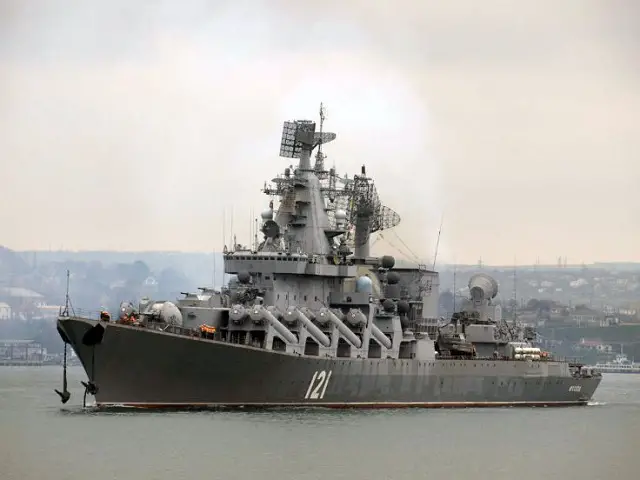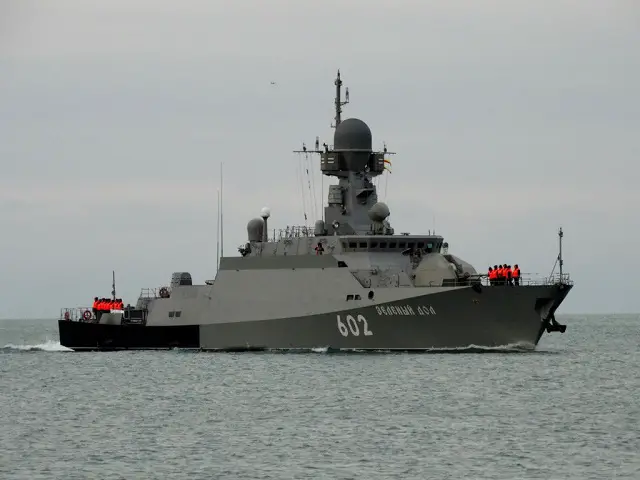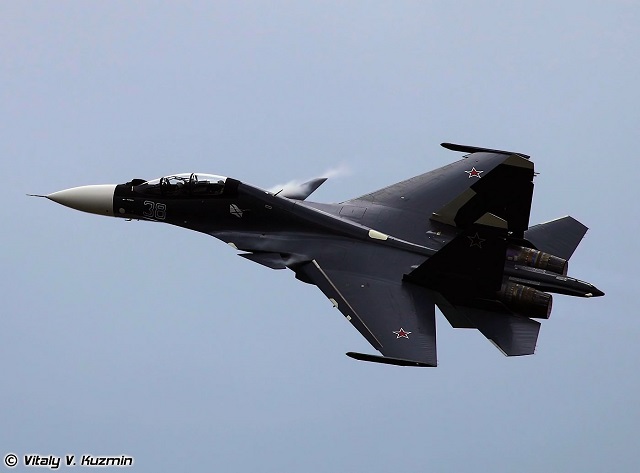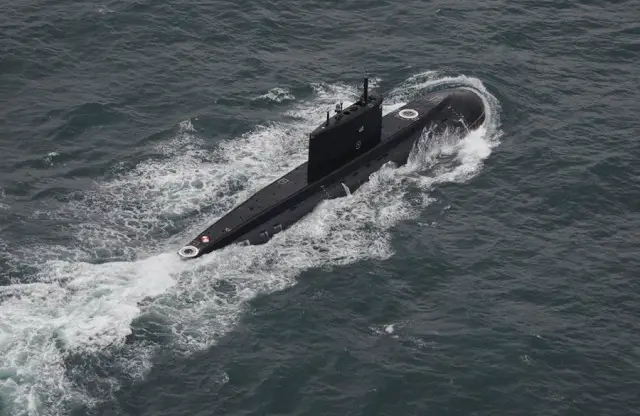Analysis: Russian Navy Black Sea Fleet Capabilities in Case of Conflict Against NATO
 Project 1164 Atlant class "Moskva" cruiser, flagship of the Russian Black Sea Fleet |
|||
The mainstay of the Black Sea Fleet’s surface
force is the Project 1164 Moskva (NATO reporting name: Slava-class) guided
missile cruiser, Project 1134B Kerch (Kara-class) large antisubmarine
warfare ship (nonoperational due to a fire) and three escort ships - two
Project 1135 (Krivak-class) ones and a Project 01090 (Kashin-class) one.
Three Project 11356 (Krivak-V-class) frigates are to join the fleet before
the end of the year.
|
|||
 Project 21631 Buyan-M-class small missile ship (corvette) Zelyony Dol (hull number 602) |
|||
The fleet’s light forces include two Project
1239 Sivuch-class (Bora-class) guided missile hovercraft, two Project
1234 (Nanuchka-class) and two Project 21631(Buyan-class) guided missile
craft, eight Project 1124M (Grisha-III-class) ASW craft, six ocean and
five base and harbor minesweepers, seven large landing ships (Project
1171 (Alligator-class) - 3; Project 775 (Ropucha-class) - 4) and six guided
missile corvettes (Project 12411 (Tarantul-III-class) - 5; Project 12417
(Tarantul-IV-class) - 5, Project 206MR (Matka-class) - 1).
|
|||
 Su-30SM of the Russian Navy Black Sea Fleet in demonstration at MAKS 2015. Picture: V. Kuzmin |
|||
An important role in the Black Sea Fleet’s air
arm is played by 16 Sukhoi Su-24M (Fencer) tactical bombers (the transition
to the Su-34 (Fullback) is nearing the end), four (some say seven) Beriev
Be-12 (Mail) ASW seaplanes, an Antonov An-12PP (Cub) electronic warfare
aircraft and four Su-24MR reconnaissance aircraft.
The branch’s helicopter fleet comprises 30 Kamov Ka-27PL ship-based ASW helicopters and eight Mi-8 EW derivatives. The Black Sea Fleet’s coastal defense forces include a separate missile and tube artillery brigade made up of a Redut mobile long-range missile system regiment, two Rubezh mobile short-range missile system regiments and a 130-mm Bereg mobile artillery battalion. The Black Sea Fleet has a separate Marine regiment. According to Sivkov, the status of the Black Sea Fleet’s ships is good. As the relations with NATO in general and Turkey in particular deteriorate, urgent steps will be made to commission as many combatants as possible with the fleet. Against this backdrop, Russia presumably will be able to use 100% of its combatant ships of the basic and light strike types and 80% of the coastal defense personnel on strength. The Black Sea Fleet’s air branch will have 12-16 Su-24Ms and Su-30SMs, two to three Be-12s, two Su-24MRs, and 12-18 Ka-27PL ASW and four to five Mi-8 EW helicopters in the airworthy condition. If the hostilities break out, the Black Sea Fleet will operate in conjunction with the 51st Air Defense Corps that will be covering the fleet’s bases and forces in its area of responsibility as part of the overall AD system. To provide AD coverage to the fleet based on the location of its forces, the corps can furnish two fighter air regiments (50-60 Su-27 (Flanker) and MiG-29 (Fulcrum) aircraft) and two surface-to-air missile (SAM) regiments. The Long-Range Aviation Command can augment the Black Sea Fleet with an air regiment to deal with large surface combatants of the potential enemy. Certainly, in addition to these forces, the Russian air task forces deployed in Khmeimim air base in Syria will join the fighting. However, its primary objective will be air defense of Russian Armed Forces installations and allied Syrian forces in Syria from the Turkish Air Force. Using the above forces after the beginning of the hostilities, the Black Sea Fleet will be able to form the following: - a force designed to destroy the enemy’s naval forces in the southern Black Sea - two to three diesel-electric submarines that can be supported by a regiment-size sortie of long-range bombers, if the latter are tasked with such); - a strike force to deal with the enemy’s major surface forces; the strike force should comprise a guided missile cruiser and three to four escort ships and be capable of operating on high seas (the strike force may be supported by two regiment-size sorties of long-range bombers); - a littoral strike force comprising three two-ship guided missile corvette groups, two-ship guided missile craft groups, 12-16 attack and fighter jets and the coastal defense force’s missile and tube artillery units; - a littoral ASW force comprising two hunter-killer groups three to four ASW craft each, two diesel-electric submarines, three to four ASW planes and 25-30 ASW helicopters. The Black Sea Fleet can support the maritime flank of the Southern Military District with its Marine regiment and six to seven amphibious assault ship able to land up to two Marine battalion on austere beaches. What can these forces do during the first week of hostilities, if the situation plays out well? They can defeat two enemy strike forces of large surface combatants, including a guided missile cruiser (e.g. a Ticonderoga-class one), or four to five strike or hunter-killer forces made up of destroyers and/or frigates. In the Russian littorals, they can do the following: - defeat up to four strike forces comprising two to three destroyers, frigates or guided missile craft each; - sink up to four submarines; - land a tactical assault party of up to two Marine battalions. |
|||
 Turkish Navy Gabya class guided-missile frigate GELIBOLU |
|||
What does Turkey have to its credit?
The Turkish Navy operates 15 submarines (including 10 up-to-date Type 209 ones), 19 guided missile frigates (including five Oliver Perry-class and six Knox-class ones), about 25 minesweepers and around 20 guided missile craft. Most likely, tactical aircraft will support these forces. According to expert estimates, 100 or more of 440 strike aircraft can be used against the Black Sea Fleet’s ships and installations. Comparing the Black Sea Fleet’s and Turkish Navy’s capabilities, the Turkish Navy presumably may lose 40-45% of its surface combatants and four submarines (27% of its overall submarine force). The Black Sea Fleet’s losses may account for 25-30% of its basic-type ships and craft, 35% of its aircraft, 30% of its coastal defense forces and one or two submarines. The estimate pertains to the Black Sea Fleet being supported by long-range and tactical aircraft. In other words, against such a backdrop, the Turkish Navy’s losses may become critical by the end of the first week, while the Black Sea Fleet remain combat-capable despite its heavy losses. Probably, the mission of gaining superiority in the Black Sea littorals will be mostly accomplished, Sivkov believes. In case of a conflict involving some of the NATO members, e.g. the United States, a NATO force, comprising two to three guided missile cruiser/destroyer strike groups supported by the US carrierborne aircraft from the US Navy’s up to three carrier strike groups in the eastern Mediterranean, will most likely enter the Black Sea. Extra 60-70 US tactical aircraft sitting at Turkish air bases may be used for attacking the Black Sea Fleet’s forces. In such a case, the Black Sea Fleet will manage to only weaken NATO’s fleet but its losses sustained in the process will be so heavy that it will cease to be an operational-level command. After that, the enemy will be able to conduct tactical- and operational-level amphibious assault operations on Black Sea coast of Russia and its allies and attack Russian military and economic facilities from the sea at will. © Copyright 2015 TASS. All rights reserved. This material may not be published, broadcast, rewritten or redistributed. |
|||



























